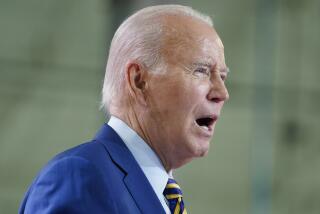Plan to Cut Health Costs Called 1st Step : Medicine: Analysts warn that Clinton must offer full reform package soon, or savings may vanish due to tactics by hospitals and doctors.
- Share via
WASHINGTON — President Clinton’s plan to cut $62.6 billion in federal spending for Medicaid and Medicare over five years is only a first step toward a comprehensive health care reform package scheduled to be finished in May, analysts said Thursday.
If the cut is to be real, Clinton must promptly follow up with a health reform agenda that not only provides coverage to 37 million uninsured Americans but also slows the growth in overall health spending--especially in the private sector, they said.
Otherwise, the anticipated government savings may largely vanish because the affected hospitals and doctors can make up for lost income by charging private patients more in a tactic known as “cost shifting,” the analysts said.
In his budget proposals unveiled Wednesday, the President proposes saving money by reducing Medicare fee increases to hospitals and most doctors, while raising more revenue by extending the current 1.45% Medicare payroll tax to all levels of income--rather than levying it just on the first $135,000 of income, the current limit.
In Medicaid, the joint federal-state program that provides care to certain low-income people, the President projects about $10 billion in savings, with more than $4 billion of that accounted for by abolition of a federal requirement that states pay for home health care.
Under Clinton’s plan to hold down Medicare fees, $8 billion would be saved by delaying scheduled increases in fees paid to doctors, with only primary care physicians to receive the full adjustment.
The exception for general practitioners did not surprise health policy experts. They have long believed that something must be done about the severe shortage of generalists, who would be in much greater demand in the kind of revamped health care system that Clinton favors, known as managed competition.
“The proposed exemption is an important first step in a series of actions that must be taken if policy-makers are to address the current shortage of primary care physicians that hinders access to basic health care in many parts of the country,” said Dr. Alan R. Nelson, executive vice president of the American Society of Internal Medicine, whose members are major providers of health care to Medicare beneficiaries.
But the American Assn. of Retired Persons said that the reduced Medicare fees threaten to make it more difficult for the elderly to find physicians willing to treat them.
Horace B. Deets, AARP’s executive director, said the group is disappointed that the Medicare savings and increased payroll taxes are being used to reduce the deficit rather than to finance health care reform.
That, he said, “does not address the root cause of increasing health care costs and may preclude options which later will be needed to make good on the President’s health care reform goal.”
The American Medical Assn. agreed. Freezing payments to physicians “in either the public or private sector is not the answer,” said Dr. Raymond Scalettar, the AMA chairman.
Max Richtman, executive vice president of the National Committee to Preserve Social Security and Medicare, which represents 6 million people, noted that $40 billion in Medicare fees were cut only three years ago.
“We’re concerned that at some point, you’ve cut providers so much, that the fallout--lack of access to doctors and hospitals, and quality of care--are going to suffer and affect consumers,” Richtman said.
The hospital industry, which would lose $24 billion in Medicare payments, also was muted in its criticism of Clinton’s budget proposals. “We realize this is a stopgap and look forward to health care reforms,” said an American Hospital Assn. spokesman.
“I see it as a holding action,” said Edward F. Howard, executive vice president of the Alliance for Health Reform, a nonprofit educational group. “But this really begs the question of what happens in the broader health care reform package.”
More to Read
Sign up for Essential California
The most important California stories and recommendations in your inbox every morning.
You may occasionally receive promotional content from the Los Angeles Times.










